Further observations about physics – split files
(30)How can we get a better appreciation of time?
[Note 4 things: this is unfinished/in-preparation, written authoratively for clarity, is probably utter bullshit and it will evolve.]
This section follows on immediately from the last point (number 29). [This whole "observation" needs a lot more thought and regular revision – so this is a temporay and evolving rendition. It is also potentially long.]
Before I start, let me explore this diagram. It was originally intended to represent 2 dimensions (not 3); hence the “sideways on" orange discs. Forget that original intention and consider it to represent a single spatial dimensional (y-axis) and a matching time dimension (x-axis). The diagram defines a cycle. Now let’s go back to the surmise about “what is a photon?" and “what is an electron?".

I suggested that the basic form of a photon is that of an oscillating – enlarging then contracting – spatial entity (perhaps a sphere of pure space). Quantum physics postulates the ex nihilo generation of photons and particles from quantum foam, a seething cauldron of fleeting, virtual particles. The process I originally imagined to explain a photon's nature was that of a rythmically enlarging then contracting magnetosphereone. reaching sero size (or Planck size) before then "enlarging" into negative spacem then contracting again before repeating the whole cycle. The crossover from positive to negative space is manifest as a point electric charge – an "electrosphere", by analogy with the magnetosphere – though this should really be termed an "electro-point" of, potentially, zero size. It repeats these pendular half cycles continuously, alternating between negative space "deflation" then positive space "inflation". Because the photon is so small it will generally be seen, by us, to be "painted" onto a much larger backdrop of the universal (positive) magnetosphere (probably a conglomeration of smaller magnetospheres). This is analogous to the flow of a very large river in which we are floating butwhere we cannot see its banks or appreciate the relative flow. From this universal viewpoint, the "pump up" phase is insinuated into a much larger (confluent?) magnetosphere that it then alternately "inflates" then "deflates" (the negative cycle). But, if it were to oscillate around zero space, we need to consider that it oscillates across time-zero [ Tzero ] alternating between positive space then negative space. That is hard to conceive when we cannot sense such a thing but the dice analogy, explained earlier, calls for this sort of explanation.
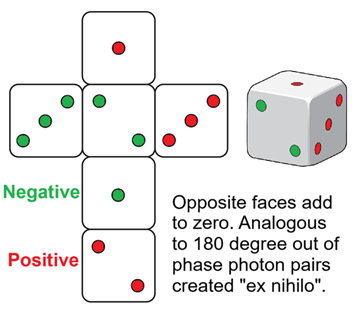
From our perspective, oscillations shunt (jump) along with each electro-point showing up sequentially along a trail and progressing (reappearing) along it at the speed of light. Analogous to one of those wild western handcars, the oscillating photon (an electro-magnetic wave – EMW) collapsesm in forward time, to cross over at zero energy, and collapsing at the speed of light, into backward time then commences a new cycle. However, the crossover point of the wave is at its magnitude nadir. We interpret this as an electric charge. The consequence of this view is that the EMW magnetosphere, at the crossover point, has a radial inwards velocity of "-c" (the "speed" of light – the SoL). The wave's emergence from negative space at the beginning of the new positive cycle is also a radial velocity of, this time of "+c". Note that the distant universal horizon is situated radially outward. Each photon's magnetosphere enlarges to a maximum distention then wanes to a minumum at a zero (or perhaps Planck) size before it repeats this half cycle in "negative distance" (sucking out); then the next reincarnation appears – Cheshire cat like – centred on the location of the subsequent electro-point but in backward time. As one magnetosphere vanishes (Cheshire cat like) a new one emerges further on, "leapfrogging" on. Since the magnetosphere is much larger than the electro-point, the progression of the magnetosphere is less dramatic than that of the electro-point; and confluence of many photon magnetospheres may blur a single magnetosphere's boundary. Furthermore, as it is at the Tzero a confluence of magnetospheres become probable and the whole "contraption" may result in a universally sized magnetosphere. Meanwhile, near black holes distance contracts and time tunnels elongate, potentially linking them together (convergence) in an intimate way that is not obvious to an Earth bound observer. So, individual photons in our parish appear to "overlay" Tzero at the SoL. That means that time appear to first drag then hurry along around the photon cycle rather than seeming to go forwards then backwards in time. Here's a nice illustration of this; initially I missed the point that the first (top) half cycle is hurrying on but you won't miss the dragging back of the second (bottom) half cycle.![]() So time is a reflection of cycle position (see the paragraph starting "My guess ... " below). This oscillation (initiated by a blow up or a suck out) can now transfer the energy of that initial push or suck across vast tracts of space to a fresh location.
So time is a reflection of cycle position (see the paragraph starting "My guess ... " below). This oscillation (initiated by a blow up or a suck out) can now transfer the energy of that initial push or suck across vast tracts of space to a fresh location.
Here's a brief aside about electro-magnetic waves (EMW) and the transfer of energy across time/distance (for EMWs, time and distance are equivalent and interchangeable – eg, we are "13.7 bn light years distance from the big bang"). The diagram below (potentially) shows how an improbable (energetic) event can cross vast distances to transfer this improbability to a distant location. The only energy constituents of this improbability should be (a) the amplitude of the EMV initiating event (this may be limited) and (b) the frequency of the EMV induced. The diagram shows how (within the green box) the "transmission line" borrows and alternately repays energy in short order; the total enclosed energy adds up to zero – whatever the distance. It is only the initial generation that is energetic and the final deposit that is equally energetic. Note that, though the diagram of an EM wave shows the magnetic oscillation and the electric oscillation as the same size, the magnetosphere is a enveloping container and the electro-point is, at most, Planck sized ("shown" in the second diagram). Also note that the energy fed into the EMW at the origin is drained out at the destination (from our perspective, of course) and the sum total of energy within the EMW remains zero from source to destination – it's a lossless transmission line.
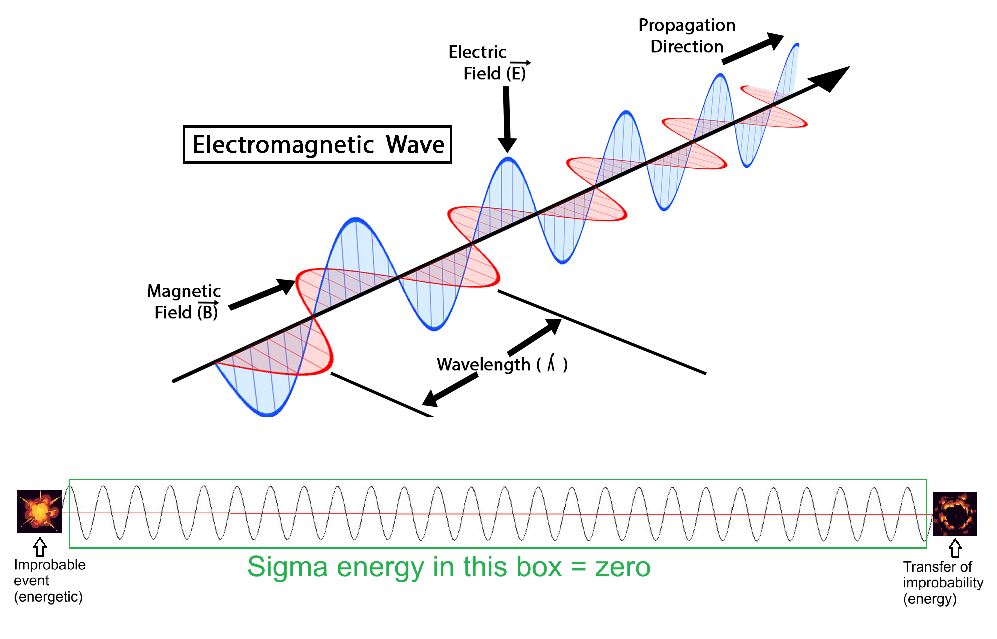
The next illustration is of a photon enlarging into universal space then into antiversal space in a pendular fashion. The top wave shows the incursion into antiversal then universal space (magnetospheres). The bottom illustrates the universal view of expansion then contraction (the antiversal view is the opposite). This just shifts both the magnetosphere growth and the electric charge growth by 180 degree. So it could be either absolute size or size change that dictates either a positive (increasing relative size) or negative (decreasing relative size) charge. So, this would imply that the magnetosphere, as well as the eleectro-point carries a charge. But, the charge of the magnetosphere is around its periphery (its spherical surface) and reflects a restoring "force" to return it to zero (nothing). But, as we have universal and antiversal bubbles, the expansion begins (from the universal perspective) at the maximal distension of the antiversal bubble, overshoots the zero point but continues to expand at an ever slowing rate until it reaches the maximum expansion of the universal bubble. Then it decreases in size creating an ever increasing negative charge, overshoots zero and then fades away. I fancy this as the better explanation of charge strength and charge sign.

But, here is an alternative view that I like better. It is essentially similar to the above view but now it is clearer that it may be a "dumbbell" bubble space that is exchanging positive and negative space in a pendular fashion (positive to negative energy and time forward to time backward) through an entanglement tunnel. This bubble analogy might just extend to the actual behaviour and the mathematics of soap bubbles; this might be worth exploring. One thing that needs emphasising is that the axis of bubble "drain-to-fill" and "fill-to-drain" is probably along the time axis (same as distance axis at the SoL), so the oscillation is, probably, alternating from a (fractional) shift left to a (fractional) shift right. This will be at right angles to the rise and fall of electrical charge (we know the crossover size should be effectively zero so don't get confused by the "size" of the electric charge in the Electromagnetic Wave diagram above). And, as the magnetosphere is comparatively very large, the universal and the antiversal sides will be largely overlapping. (This proves to be important later as the zitterbewegung oscillation of an electron must be across the time/distance axis and the electric charge will appear to lie, otherwise, in the centre of the antiversal and the universal magnetospheres). If this is right, the crossover is pretty much central to the surrounding magnetosphere and collapses to a "point" at the SoL down into the "antiversal plughole". Note, also, that the EMW bubble is collapsing radially down this "plughole" and that it emerges radially at the SoL out of the "plughole". So, in a moment, when I discuss electron/positron pair generation, it clearly suggests that photonic packets of energy will reach and leave electrons or positrons at the speed (radial velocity) of light and that photonic energy absorption goes into and energy emission comes out of the "plughole" to inflate or deflate their respective magnetospheres and thus force a change in atomic orbital (because it can or cannot fit within a particular orbital at that energy level – equivalent to magnetosphere size). (I'm losing faith in this exact interpretation – it has problems. The answer may well still be hidden in here – more evolution needed. I cannot get my mind around a physical meaning for time backwards that makes fulsome sense. And, this dumbell thing may have a rudiment of value but it has problems as currently conceived. I still think that the entanglement tunnel is important. Perhaps every "now" – has an immediate attachement to the converging tunnels through to a black hole conglomerate and so through to "the big bang" (illusion?).It needs much more thinking.
).
So, sone thinking has been done. This has been bugging me no end. What is negative space? What is negative time? What is negative energy? Is it real, relative or illusory. I already accept that the universal view of the antiverse is that we are in its past and that the the antiversal view of the universe is the we are in its past. The answer may lie in some alternative thinking. But, let's start with the entanglement of particle A and particle B (for example) and what we know of it. It connects two systems that were "originally" generated together so that, when particular properties of particle A are established, this is instantaneously reflected in a mirror property in particle B – however far apart they are. This does not appear to be useable as a communication device (for example, telling particle B how to behave). This "communication" is not restricted by the recognised speed limit of "no faster that the speed of light". So this is important, because, the idea that I have been moving towards is that the oscillating spatial dumbbell that constitutes an EMW probably has an entangling bar/tunnel that connects the two ends and this connection is either oblivious of time or happens far faster than the speed of light. I got stuck because I suddenly "realised" that the space in the "universal" magnetosphere ought to be positive space and that in the "antiversal" magnetosphere ought to be negative space so they cannot "pump" alternately from one side to the other because they would simply annihilate. BUT! That is probably wrongly conceived. It probably does alternately transfer its inflation deflation from one to the other and that now gives us an extra two clues. I've already conceived that magnetospheric pumping occurs at either end of an EMW with the EMW acting as a transmission line – so the principle is already "in situ". So, "within" the antiverse and "within" the universe, transfer of magnetospheric space "travels" at the SoL limit in transfers between antiverse to antiverse systems and similarly between universe to universe systems; also, if neutrinos are antiversal leptons, then we know it is very rare that a group of neutrinos will interact with a universal system – they would rather burrow through a light year of solid lead before 50% of them interact with universal matter. At the moment that an electron positron pair are created (manifest as point lepton charges in the crossover tunnel), they two electron and the positron are separating at twice the SoL (we should be calling it a Velocity of Light – VoL). By the time they have each converted all their kinetic to potential energy (the magnetospheric phase) they are increasingly moving towards occupying the same space as each other and all the energy is turning from kinetic to potential energy. We can see this in the way that dark matter forms a halo around matter and that galaxy collisions "briefly" separate universal from antiversal matter. They do not continue, for ever, to separate faster than the SoL.
The second point is that, now, the entanglement tunnel seems very likely to be like an EMW transmission line that is not restricted by the parochial speed limit that restricts transfer from universal electron to universal electron (or antiversal positron to antiversal positron). There are two ways of going around a universe when it's beginning is also its end. We can go "the short way" round (for us this seems the forward time way via a black hole) or "the long way" round, heading off into deep intergalactic space towards the BEC and this would seem to us to be the backward in time route. When resticted to the speed of light, this would take 13.7 bn years at least. However, we already know that a photon (or light wave) does not feel any passage of time, so, as far as it is concerned, it can be across this same space in an instant and it doesn't have to think "hhmmm ... I'm going backwards in time". There may well be no "SoL" speed restriction provided you are not trying to transfer a dollop of space from one universal particle to another universal particle. If you are trying to transfer a dollop of space from a universal particle to a receding antiversal particle, you will have to wait until the dilutional red shift allows the wave length to elongate and, so, effectively trade speed into an appropriate frequency to enable it to interact and inject itself into an antiversal entity. So, the "short" way around (as it appears to us) is "time dominant" spacetime and the "long" way around is "space dominant" spacetime. The "short way" appears to us to need to move forward in time, while he "long way" appears to us to need to move backwards in time. These thoughts almost certainly needs refining but it is moving towards an explanation that amuses me. And that also leads into the idea that the centre of every particle, planet and star is interconnected by a converging web of entanglement tunnels right through to black holes and eventually the (so called) big bang. A loss of speed restriction from the "far side" of a black hole event horizon (a white home) might be a short route through to the BEC and look, to us, like "cosmic inflation". I am also guessing that the increasing trade off of distance for time that occurs in planetary and galactic orbits results in a reality that "the centre of the earth is actually accelerating out to hit us"; this becomes a dramatic and dangerous situation if ever we find ourselves to be in freefall (note how small 10m/sec/sec is conpared to Earth's radius which is approaching a million times larger than 10 metres).
At this point it is worth noting the possibility/probability that gravity is essentially an electrostatic force. It is quite likely analogous to Zwitterion charges in molecules, where – as the separating distance increases away from the molecule – its charge appears increasing close to zero but as we approach the molecular dipole, one ion becomes substantially closer than the other and this produces a proximity imbalance in the apparent charge. As all universal matter is coated with a skin of electrons, the proximal charge, for us, is negative. The proximal charge for the antiverse we would view as positive (positrons from our perspective). So, as the concentration of matter increases, so does the proximity of antimatter and there is an increasing imbalance as we get closer to neutron stars and black holes. This is best illustrated by comparing the equations for electrical attraction and gravitational attraction. I have taken the liberty of separating the 4πr2 element of G and designated the result as an inverted G. This makes the analogy more obvious and emphasises that the magnetospherical charge surrounds the electro-point like the surface of a sphere. The dipole effect occurs radially out or in (from the crossover point); positive electrostatic charges are only thinly distributed radially out into deep intergalactic space but they are increasingly denser and concentrated in towards the progressive agglomerations of groups of atoms - so leading to a dipole imbalance that we interpret as gravity. M1 and M2 now equate to the negative and positive "Zwitterion" imbalances and, as they are obligatorily opposite in sign, gravity is always attractive and never repulsive.
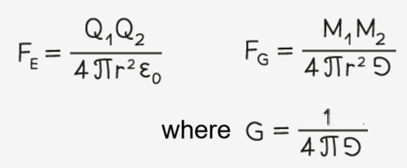
This is another representation of the same process with clearer "tunnels". The two versions are complementary in explanation. The newer one is rather congested so I have left the old one in situ. The universal view is that the photonic package travels (unequivocally) from the past to the future. However, the antiversal view will be the same BUT, if we could observe it from the universal side, it would be flowing the other way. Perhaps this is what we do observe when we decide that neutrinos "oscillate". This may simply be the result of the naive expectation that tau neutrinos should decay to muon plus electron neutrinos and then to electron neutrinos. The naive universal expectation is that tau neutrinos should decay en route towards us (the furthest should have more tau neutrinos and the nearest more electron neutrinos). If the flow of time is reversed for neutrinos, we should expect a trend for some electron neutrinos to go to muon neutrinos then tau neutrinos as they get closer to us. This also fits nicely with the view that our naive cause and effect of photon energy packet transfer is a universal view. The antiversal view will see things starting and finishing at the opposite ends to the universal perspective. So the electromagnetic wave connection between an emitting electron and an absorbing electron is probably a time ignoring, two way, entangled, "transmission" line. So, this representation makes it clear that, whilst the accepted universal "flow" of wave packets is from left to right, the antiversal view will be the exact opposite – it's a zipperlike contra-rotation (jumping up many fractal generations to the universal scale this might translate to the mirror universe).
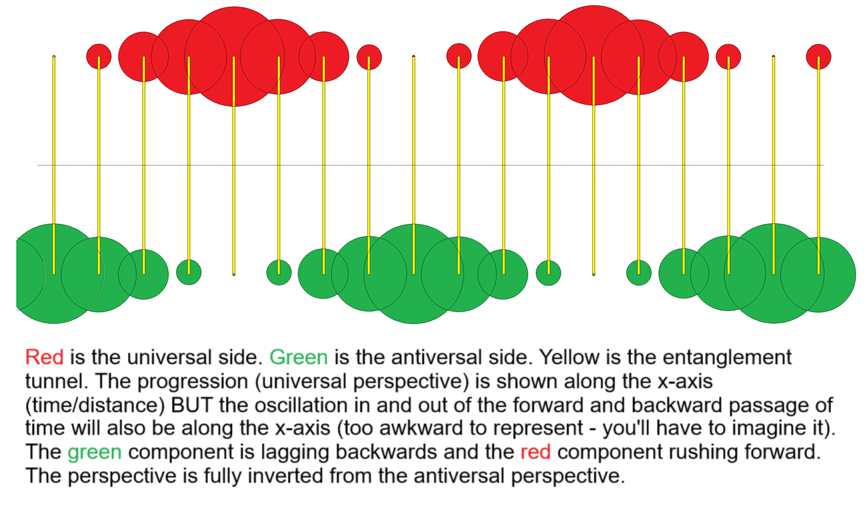
The next diagram is meant to represent two photons beginning to entangle to form a two photon system (top pair) and the outcome after entanglement is effected established (bottom pair).
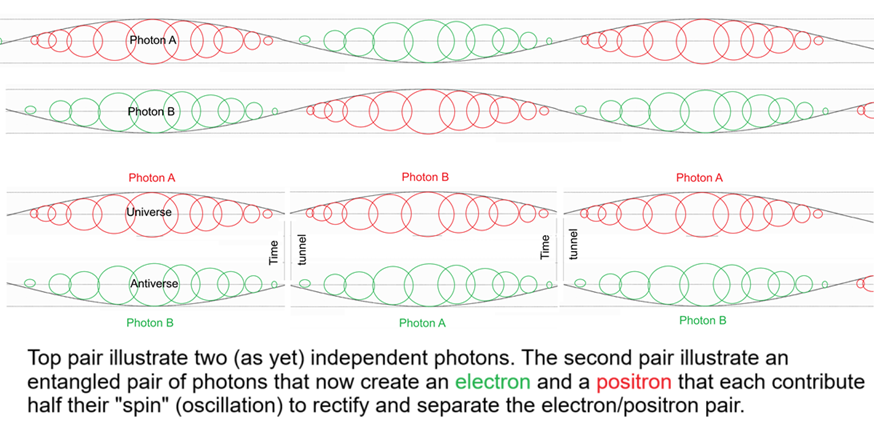
This diagram above illustrates how these two photons might entangle to create an electron/positron pair. Note that Dirac's equation suggests that an electron/positron pair can be created across Timezero (Tzero) leading to a universal electron and an antiveral positron. So long as rectification can be sustained, they will not annihilate (to nothing, zilch, nada, nihil – true annihilation like the black parts of an interference pattern). Alternatively, an electron/positron pair can be produced by some violent reaction (in universal space) generated by strong EMWs to form an electron positron pair; and contrariwise in antiversal space. These will disintegrate into pure energy (NOT annihilate) if they manage to interact with each other. The practical evidence for this is that there is an extreme imbalance of electrons over positrons in the universe and the opposite holds for the antiverse. Like evolution of chiral forms in biological evolution, the "glass table dice" (mentioned earlier) will enable the gradual dominance of either electrons or positrons given enough time (plenty of that at Cu-3u and Ca-3a – in the time torus diagram above) and with the suspected seething cauldron of pair creation in quantum foam. It will simultaneous ensure that the antiverse is populated by the opposite electric charge (eg, universe electrons, antiverse positrons – or vice versa.) So mass is residual electric attraction (negative electron skins to positive entanglement tunnel charge and as it is an electron positron pair the total stored kinetic enerrgy is {2 x 1/2mc2}.

[This paragraph is wrong as stated: I'm mixing up photon waves and rectified electron system waves. This needs a big rethink. Nevertheless, the idea of the filling of the Orbital space is an attractive one. Back to the thinking cap! Post thinking! I have looked at this and I think that a second electron sawtooth 180 degrees out of phase will fit within the same volumme. But it's raising questions about the electron sawtooth or the magnetosphere sawtooth - the second I'd hoped for. More thinking!] This illustrates how the Pauli exclusion principle might emerge with two electrons in the same orbital. One standing wave of electron 1 is shown with a 180 degree out of phase electron 2 standing wave. The volume demanded by photon 1 will still be the maximum extension of the expanding magnetosphere. So, it's easy to see that combining the two will demand no higher volume than one photon on its own. The next thing is to visualise how these rotate (if at all). The (virtual?) position of the electron's negative charge will be central (the middle of the atom and hovering over the entanglement tunnel through to the surrounding antiverse, although we will not interpret it to be at the centre of the atom. The non-callapsible magnetosphere will maintain its apparent distance from the "nucleus" (and thus give us the impression the electron orbits the nucleus) and the nucleus will be composed, most centrally, of an antiversal positron ring held out in the same fashion but rectified and at some distance from the electron orbital (where it was a very brief time ago). As proposed earlier, quarks and all the other nuclear particles are probably an entanglement tunnel view of electrons and positrons doing various "dances" as they "disappear" down (really radially up) the entanglement tunnel and so appear to create these complicated nuclear particles. [That's what I'm currently thinking. It could all change in an instant.]
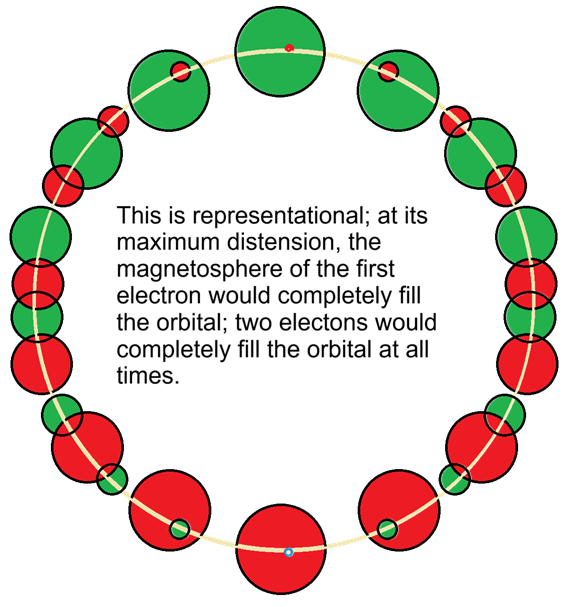
This illustrates that the universe's positive magnetospheres are large and enveloping and that the "sawtooth" rectification of the electric oscillation is point-sized (or perhaps Planck sized). The natural zitterbewegung might actually dictate a minimum "size" – eg, the SoL divided by the the frequency; 10-17 metres by one estimation of zittebewegung.
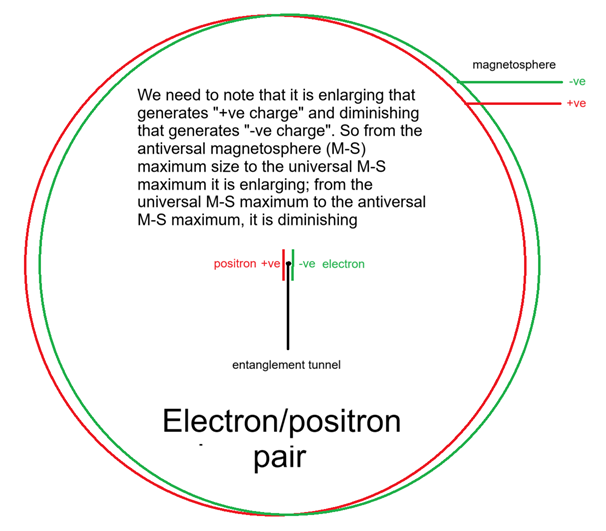
So, after this preamble, let's surmise that a primordial electron/positron pair is constituted from two entangled photons (generated ex nihilo out of balanced energy loans that are equal in magnitude but opposite in "direction" – perhaps this means an intrusion into forward and backward time). I have already assumed that a muon would be made of three photons and a tau from five; non-primes would "split" into their constituent primes. Returning, now, to electron/positrons, the photon pair would contra-oscillate in an pendular "dumbbell" fashion, inflating the universal side then deflating before it re-emerges to inflate the antiversal side for one photon and the opposite direction for the other photon. One photon inflates the universal side and the other the antiversal side, then they cross over to do the opposite. Inflating and deflating in forward and backward time are probably equally interpretable as positive and negative energy and the swap in direction of the magnetic field also goes with a flip from forward to backward time. Since, at the speed of light, time and distance are equal and interchangeable, forward and backwards in space is also an implied consequence – 1 second ago is a definite place but we are unable to access it. Our problem is that when a large number of electrons create a skin for all matter, backwards in time must be reached by overcoming electrostatic repulsion, breaking down the fermi/pauli exclusion principle and then by going through the aggregate of all the entanglement tunnels to reach our destination. So we firmly believe that there is no time backward place. However, one second ago is a definite place that we are denied access to. This barrier also makes a formiddable dialectric and a universal/antiversal capacitor is formed where the strongest of electric charges of opposite signs are kept tiny distances from one another. Now and the past are less that femptoseconds apart; and the antiversal view is that we are in the past. Back now to the electron/positron pair: each photon of the pair enlarges to a maximum spatial volume in forward time then contracts to cross over then enlarges to maximum size in backward time but in a balanced counter-pendular fashion. They retain their entanglement tunnels (this will be along the time/distance axis). All matter (as we experience it) is primordially created from electron/positron systems; their constituent magnetospheres are an integral part of that system. When a positron/electron pair is superimposed on a much larger spatial bubble eg, like onto the amalgamation of magnetospheres ranging from us to 13.7 bn light yrs distance away, we won't appreciate it to be a forward an backward in time oscillation but only a hurrying forwards (acceleration) and hanging back (deceleration) in the rate of the "travel". Unless there is some condition that keeps the newly generated electron/positron pair apart they will very quickly revert to their constituent photons. If these generated the pair across Tzero, they will truly annihilate to zero (zilch, nada, nihil, nothing). However, if they were created by firing very intense radiation at lead (for example) all the constituent energy will be positive and fundamentally "universal" and, when they interact, they will disintegrate explosively into their constituent photons. Now, were we able to "fire" one very energetic photon from one direction at a similar one coming from the opposite direction, could we persuade them to entangle and reach a physical status where they rectify universal excursion from their antiversal excursion. Remember, I have suggested that the SoL "speed" limit that we observe may really be a velocity of lepton absorption / lepton emission property. It is what is required to enter or leave an electron (particularly when in an orbital) and this entrance or exit inflates or deflates the electron's magnetosphere, forcing it to jump out to a new orbital or sink down to a lower orbital that it can now fit into. All our sensors rely on electron absorption or emission. This also suggest that the emission-EMW_bridge-absorption of a photon is an entangled system that we insist on interpreting as starting at one place and one moment, then travelling independently at the SoL, then arriving independently; however, it may be an entangled system that doesn't have to "think" cause and effect. A "greater than the SoL separation" seems a possible rectification mechanism. That would fit nicely with antiversal electrons (that is what I suspect neutrinos are). These very rarely get a chancy "kick down" to the SoL where they can interact with matter (vs antimatter). They won't be far off the SoL – the tiniest bit faster is enough to guarantee the initial and the continued segregation. Now we could be left with two independent leptons, each static in its own realm, owning either the time forward (half) domain of each photon pair (the electron) or the time backward (half) domain of each photon pair (the positron). There is more on this in "Some observations" point number 14. These two leptons are interconnected, not only by a distance, but also by a (potentially very large) time tunnel and are, thus, entangled. Experimental experience shows that they can now also be separated physically by an increasing or decreasing distance – perhaps having to give up some (space)TIME in favour of some SPACE(time). The entanglement tunnel can also appear to be very long (this may have implications for the bubble representation of EMWs given above). Whatever, the electron is effectively "rectified" to separate it from its entangled positron; and some condition – perhaps a separation faster than the SoL – keeps them from annihilating one another to nothing (zero, zilch, nada, nihil). So how big can the confluent magnetosphere of a group of electrons grow to exert their influence? Should this "antiverse" constitute dark matter, then we know it forms a large halo of influence around galaxies and reinforces the idea that the past is a place. And, on the grander scale, it could expand into the whole universal/antiversal volume. Dirac's equation suggests that there are 2 types of positron/electron pairs. There is the positive energy electron partnered by a negative energy positron (rectified) that would truly annihilate to nothing (think black areas of an interference pattern); and there is a positive energy electron and a positive energy positron (and the antiversal opposite) that will (in short order) disintegrate back into their constituent photons when they meet.
The following diagram emphasises several points. The top "funnel-tunnel-funnel" diagram represents an electron/positron pair entangled together. The magnetospheres of the electron and positron are both distant from the electron and probably converging towards the same physical space – so capacitatively reducing the charge seen at a distance – and the most proximal positive electric charge is radially inwards, down the entanglement tunnel. This will act as a Zwitterion-like attraction. In fractal manner, this schema will be "blown up" at a larger scale to include many electrons around a single atomic nucleus (and then, an even larger fractal scale, many atoms together – and so on). BUT, the quarks are views down the (converging?) entanglement tunnels, fundamentally made up of electrons and positrons (as introduced earlier "Some observations" point number 15.) This top diagram can be milked for some more insights. Our electron "skinned" universe is (at the point of rectification) collapsing radially at the SoL, but this will change as the kinetic energy is converted to the surrounding magnetosphere's potential energy. Ultimately, the universal and antiversal magnetospheres begin, progressively, to overlap but the electron shells remain "separating" at twice the SoL from the positronic antiverse. And, that also points out that, "piggy in the middle", photons appear to be "travelling" at the SoL; but this now implies that light itself is "stationary" with respect to the mid point between the distraction of the antiverse's and the universe's lepton shells. The lower four figures represent photonic oscillation. The middle two of these, with equal spatial magnetospheres, illustrate the uncertainty where quantum foam can't decide whether it wants to be positive energy (we'll label that kinetic energy) or negative energy (we'll label that potential energy). The total average energy of "a uniiverse from nothing" is zero, so the sum of its kenetic energy plus potential energy is also equal to zero. They should cancel each other out. Under all but the rarest of circumstances they will only produce virtual, transient, photons (and any leptons, and etc, that these manage to birth). Now we get a clearer idea of what time might be. It's the difference in distance from the short way back (which is blocked by an intervening, rectifying dialectric that separates the universe from the antiverse but which "creates" a matter/antimatter capacitor), or the long way round. Every "now" constitutes a "capacitor" like this, so I am warming to the idea that there is, effectively, an antimatter version of me writing this prose in a zipper like inversion of the sequence I feel. I only experience time "forwards" because I am on the universal side and cannot connect with the antiversal side (I would have to break through the repulsive electron shells, overturn Pauli's exclusion principle and communicate with the antiverse – that is receding at twice the speed of light). What the system has achieved is a testing ground to achieve an evolution of increasing complexitity and at a point of greatest fractal "flow". That's absurd isn't it? But could it be so? Perhaps.

This oscillating photon pair crosses over at zero size (or perhaps Planck size) with the collapse reaching what to us appears to be the speed of light. Meanwhile, the point of maximum distention of its magnetosphere also experiences no dragging or hurrying on of time – so its influence could possibly linger from our perspective. The elecro-point effectively shunts (leapfrogs) along one magnetosphere's diameter at every oscillation both in forward and backward time. The contra-rotating photon pairs cross over at twice the speed of light and at zero size; then we are left with an electron/positron pair constituted from half the spin of photon A and half the spin of photon B in forward time (an electron) and half the spin of both photon A and half the spin of photon B in negative time (a positron). They would almost immediately "annihilate" unless there is some condition that rectifies them. Stephen Hawking developed the idea that this could happen over an event horizon of a black hole. But, for generation ex nihilo we'll have to imagine this "starting" at the surrounding Bose-Einstein condensate (BEC). Here, quantum uncertainty allows a rich generation of virtual particle pairs and we must imagine that, if these are generated out of nothing, the electron is in a positive energy "field" and the positron in a negative energy "field". The simplest explanation of this is that the electron is generated in forward time and the positron in backward time or that positive energy generates forward time and negative energy generates negative time. Since they are part of a cycle, they "agree" on a perfectly balanced "loan" from each other that can be paid back at some point to return to zero energy (nothing – this invokes time). We are back to the analogy of dice on a glass table. Now imagine that there is a potential state that can somehow "rectify" occasional virtual particles and that this leads to a balanced mirror image universe/antiverse generator. Now we can use these diagrams to explore various relationships.
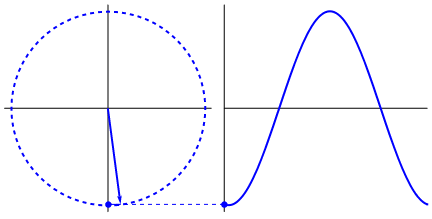
Note, this would represent only the enlarging/diminishing photon B, for example, and that a mirror image of this animation (with the radius rotating clockwise) would represent photon A. In "Some observations 14" I have shown the superimposed half sine waves generated from photon A and photon B and this goes a little deeper into the rectification process. The frequency of this rectified electro-point is probably around 1021 Hz to 1024 Hz. This corresponds to a theoretical intrinsic oscillation in an electron (zitterbewegung)![]() . Donald Hotson suggests it around 1024 Hz
. Donald Hotson suggests it around 1024 Hz![]()
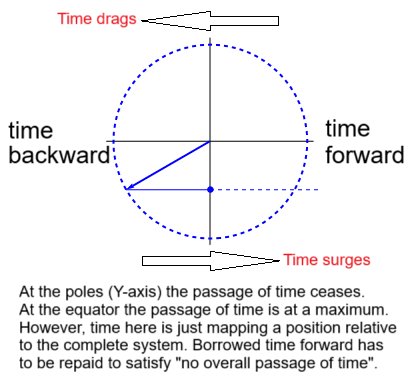
My guess is that we have to get rid of time as a dictating "element". It needs to be replaced with a respective sequence of space and position. The universe/anti-verse is strung between the enveloping BEC the central converging coalescing black holes. The latter are not necessarily "close" to each other from our perspective but they may be much closer viewed from the passage of time that they "own". It's a time funnel (not a distance funnel) through to point Z. Their "singularities" are stuck at Tzero (time zero). Any change that shrinks one dimension is probably compensated for by a reciprocal transfer to the other. The overall dimension/energy is unaltered. Note that the statement "energy can neither be created nor destroyed" is accepted as a fundamental principle of physics, known as the law of conservation of energy. This law states that the total energy of an isolated system remains constant; it is conserved over time. And that gives us a clue as to how a universe/antiverse system can be conjured up out of nothing (which appears to contradict this law – as, incidentally, does "the big bang"). This "law" states that it is conserved over time; I'll add "within one time system". It's conserved in the antiverse and its conserved in the universe so long as they stay rectified and unable to interact with the antiverse. So this law holds – in our parish. Rectification leads to a parochially isolated system.
The time/distance torus depicted in the diagram represents only one dimension of distance and one of time. But there are three dimensional distances all at right angles to each other so there should be 3 corresponding dimensions of time.
A gyroscope demonstrates how rotation in 2D alters spacetime in the third dimension (perpendicular to the rotating disk). Effectively, the third dimension changes and needs more effort to shift it (translate it) in a rotatory fashion. If we envisage this effect being translated to the 4th dimension (or more), then we can imagine an increasingly restrictive inhibition on rotation of each extra dimension. What about 2D to 1D? Is there a similar inhibition? How could we envisage this?
Now, for leptons: please note the earlier conjecture about entangled photons in prime number combinations (only primes demonstrate no resonance and so cannot be split). Here, we can see the exponentially increasing energy (improbability) needed to create each new generation (electron[2] – muon[3] – tau[5] – next?[7] – and etc). Here on earth, we don't see prime leptons beyond taus and even then the latter are rare and highly energetic (that amounts to more improbable). This is reminiscent of light frequency and photonic packets; red light is common, of a lower energy and more probable than blue light, which is rarer, of higher energy and less probable.
Earth's position (within the Milky Way) is likely to lie somewhere in the vortex throat down towards the singularity.
Perfect balance means that a Cu-3u rotation should be matched by an opposite rotation of Ca-3a. That could mean that, on meeting at Z, the rectified matter may be able to interact (the rectification is finally "broken") and true annihilation is able to proceed.
Relationships
Cu to A A is in Cu's past
Cu to Z Z appears to us to be in Cu's future
Ca to A A is in Ca's past
Ca to Z Z appears to antiversal beings to be in Ca's future
At the singularity, there is no passage of time – it is at Tzero ; so by the time an object at Cu finally reaches Z it has to have paid back its forward-time debt. Similarly, a photon leaving Cu to go to A has to pay back a similar time-forward debt. As they close in on A, photons appear to become redshifted (from our perspective).
So this makes it clearer why matter in the antiverse seems to be travelling at twice the speed of light away from matter in the universe and why it remains rectified (in our parish). The electro-point of an electron is travelling at the SoL relative to Tzero and the aniversal "positron” is moving away from Tzero at minus the SoL. So their distraction is twice the SoL and their combined kinetic energy is either twice their individual kinetic energies OR their kinetic energies cancel each other out.
1/2mc2 + 1/2mc2 = mc2 – when the electron/positron pair is on the universe side of Tzero
1/2mc2 - 1/2mc2 = zero – when the electron/positron pair straddles Tzero.
Chance may allow occasional neutrinos to meet rare circumstances where they approach to dock with a universal atom at the SoL and thus provoke Cherenkow radiation. Note that the primary interaction could be of an originally antivesal positron meeting an electron and the pair evaporate into pure energy (the antiversal positron - seen by us as a neutrino, has been kicked into the universal environment).
Effectively, then. we can envisage various dimensional axes. We have:
T1, T2, T3
and
D1, D2, D3
As noted earlier, in previous "Some observations", the SoL speed "limit" may simply be a need for photons to dock and undock with matter at the velocity of light. With our detectors, we cannot "see" or interact with photons outside this specification. When receding at the speed of light from the mid point (Tzero), time is reversed on either side. But like relativity twins, Ca sees Cu in its past and Cu sees Ca in it's past. But this differential is only because of borrowed time; antiversal "beings" would regard their perception of "time forward" to be reversed to our perception of it. The antiversal or universal matter is effectively rectified and thus cannot interact (dock with atoms on the opposite side). As we move closer to the BEC or closer to the singularity, the passage of time converges towards zero and, at these poles/equators, time ceases to be a dimension (exist). It is now only space and position. Everything is simultaneous (or should it be called timeless). So, a photon at the speed of light can be across the singularity to the BEC instantaneously as far as it perceives the "journey". However, across 3u to Cu only photons travelling at the speed of light will interact with baryonic matter. 3a to Ca will only interact with photons we perceive as travelling at twice the speed of light. So there are now two mirror universes (universe and antiverse) that are effectively kept apart by rectification even though every constituent lepton (and all the particles that these then beget) are entangled. Every universal electron has an entangled antiversal positron partner. They are an integral unit and can not exist without each other. Their net energy is "zero, zilch, nothing, nada, nihil”. From the antiversal perspective, of course, this positron twin acts exactly like what we regard as an electron. So the gravitational attraction of matter to dark matter results in matter having a halo of dark matter (dark matter outside of universal matter) and, reciprocally dark matter (from the universal side) is a halo outside antiversal matter. Once again, gravity is probably a residual electromagnetic "attraction", akin to a Zwitterion molecule whos' overall charge is net zero but proximity to one end or the other of the molecule results in a local charge imbalance brought about by greater proximity to one end or the other.
Dimensional relationships:
T1-D1
T2-D2
T3-D3
These three are the classic space-time dimensions. Then we have pure spatial dimensions:
D1 to D2
D2 to D3
D1 to D3
Also we have pure temporal dimensions:
T1 to T2
T2 to T3
T3 to T1
These multiple possible dimensional distances are only maximum at Cu-3u and Ca-3a. Is something like T1 to D2 impossible? or so improbable that it doesn't have a significant impact on the “spacetime pot"? This combination of T and D dimensions offers an explanation for the need of "i" (the square root of minus 1 in various quantum mechanics formulae). If the hypotenuse used in Pythagorean calculations (abundant in trigonometry and cyclical maths) is space time rather than just space, we could be mistaking the hypotenuse for the adjacent in many of our calculations. This can be arbitrarily fixed by using "i" in the equations.
Now, two last points.
First: I have assumed that distance is non-cyclical BUT, if it were cyclical, then the BEC (as well as the singularity) would be zero size and zero time; that sounds an awful lot like nothing (zilch, nada, nihil). Hhhhmmmmm????? Perhaps the cycle could be A to Z where A and Z are convergent and the universe and mirrored antiverse runs along, side by side, in opposite directions in a zipper like fashion. It's worth a thought.
Second: It seems to me that the basic pattern of electron/positron pairs emerging from the interaction of two energetic photons (positive and negative photons in the case of the "enveloping" BEC) is repeated in a fractal nature right up to two mirror image universes running forward and backward in time. So the [BEC] - [universe_collapse_to_singularity] - [antiverse_expand_from_singularity] - [BEC] cycle may be the fractal (very!!) big brother of an electron_positron pair (this probably needs conceptual editing). Similarly, just as black holes may "converge" through ever diminishing physical dimensions but ever "lengthening" time tunnels; so in an atom (the next fractal generation – up – following photons then leptons) the atomic nucleus is in the same kind of [spatial_collapse_to_time_tunnel] lengthening process. "Gravity is the past rushing out to fetch us back" (an earlier surmise) takes on extra meaning now. The dimensional collapse down a time tunnel is 3 dimensional. Everything is collapsing down (eventually) at the speed of light to a point when it then takes a (bidirectional) contraflowing time tunnel through to its mirror image (universe_antiverse and electron_positron). So the conditions that beget protons and neutrons are taking place along this time tunnel (as proposed in an earlier "Some Observations").
There are some themes starting to emerge in my mind that may prove relevant. Entanglement seems now to be, possibly, a faster than light electromagnetic wave (EMW) that, in particular, links elements of the antiverse to the universe; it's a way of ensuring the mirror image status of the two "sides" remains "true". That, in turn, suggests that standard SoL transmission along an EMW is also a form of entanglement. This time, deviating from our perspective that it transmits the source event (and its energy state) to the target consequence. This view sees the departure from the source effectively amputating it from its arrival at the target. We believe that the target cannot influence the source. But that is not consistent with the idea that time direction is "readable" both in "forward" and "backward" directions along an EMW. I suspect that the source remains systemically linked to the target to establish a system. Our perspective of it is that the target is rigidly unable to affect the source. But, the wave will not "leave" the source unless it "already knows" that it is able to transmit the packet to the target; it is a working system. That, again suggests that a faster than SoL EMW entanglement ensures mirror balance whilst the SoL entanglement allows the "table top" to juggle and explore myriad posibilities so long as they stay rigidly linked to the mirrored system. It's a bit vague yet – but I think that I like it. It certainly continues the theme that basic "structures" are continuously adapted and reutilised in a scaling up process (fractal like).
Here's a mini-aside. It is tempting to think that the atomic nucleus is inside the electron shell, connected through a "tube" of some sort. I suspect that it will prove better to think of it as an apparent nucleus within the atomic shell; but it is really a reflection of the immediate surrounding antiverse (the capacitor bit; remember we are in wave characteristics at this scale). This is constantly "zipping though" countless antiversal leptons. Quarks are made from the apparent arrangements of these flitting "virtual" exchanges. That sits nicely with the one third or two thirds charge that would correspond to lepton shells with a single or a pair of leptons. Because this is all heppening at (?) twice the SoL (the "tunnel" connecting the two photons making up a lepton) they cannot annihilate but they they can act as a highly effective capacitor. Electric repulsion and Pauli's exclusion principle maintain this "dialectric". This fits nicely with the quantum idea that we are surrounded by a sea of virtual particle that are constantly being exchanged (as in Feynman diagrams). The maths of quantum physics, it seems to me, is rigorously logical (not magical – which is the impression we are often left with) but lacks the appropriate imagery to make common (Newtonian) sense of it. Perhaps these ideas can go some way to resiolving this. Who knows? Whilst you might counter with, "When we fire a particle at an atomic nucleus it is targeted at a particle in that nucleus", it will – of necessity – be at the point of losing it's particle definition at these dimensions and acting ver much more like a wave. Here, reflections and holography are more likely to contributeto what is happening. So the target could be projected into the surroundings; it's not necessarily impossible.